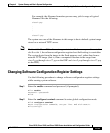
4-37
Cisco 12010, Cisco 12410, and Cisco 12810 Router Installation and Configuration Guide
OL-11496-01
Chapter 4 System Startup and Basic System Configuration
Configuring the Software Configuration Register
Low-Order Bits in the Software Configuration Register
This section provides detail about of the low-order bits in the software
configuration register and how they interact during the router boot process.
As described in the “Setting Software Configuration Settings” section on
page 4-33, the boot field setting determines the source of the Cisco IOS software
image used to boot the router.
• If you set the boot field value to 0 (0x0000), you must boot the operating
system manually by entering the boot command at the ROM monitor prompt
(
rommon>).
• If you set the boot field value to 0x2 through 0xF and a valid boot system
command is stored in the configuration file, the router boots the Cisco IOS
software image as directed by that value.
• If no boot system command is present in the configuration file, the router
forms a default boot filename and attempts to acquire that file from a network
TFTP server.
In the following example, the software configuration register is set to boot the
router from the flash memory SIMM on the RP, and to ignore the Break function
at the next reboot of the system (see Table 4-4):
Milo# configure terminal
Enter configuration commands, one per line. End with CNTL/Z.
Milo(config)# config-register 0x0102
Milo(config)# boot system flash filename
Ctrl-Z
Milo#
With the configuration register set to 0x0102, the system computes a default boot
filename. In forming this filename, the system starts with cisco and appends the
octal equivalent of the boot field number, a hyphen, and the processor type (grp
or prp).
Table 4-6 lists the range of possible computed default filenames for booting the
system over the network. Note, however, that a valid boot system configuration
command stored in the NVRAM configuration file overrides any computed
default filename for booting over the network.


















